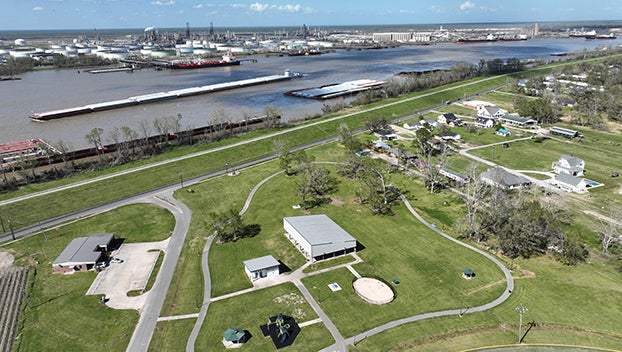West Bank of St. John under consideration for National Historic Landmark designation
Published 9:00 am Saturday, August 5, 2023

- The West Bank of St. John Parish is seen from an aerial view with Garyville visible on the opposite side of the river. (Photo credit: Louisiana Trust for Historic Preservation)
|
Getting your Trinity Audio player ready...
|
EDGARD — With sprawling oak trees and sugarcane fields bordering centuries-old plantation homes, the West Bank of St. John the Baptist Parish appears almost frozen in time.
`The 11-mile stretch of land along the Great River Road is now the subject of a one-year study for consideration as a National Historic Landmark, a designation that can improve access to grants, tax incentives, and other funding for historic preservation and rehabilitation.
The study, expected to run through Summer 2024, is being conducted by the National Park Service with assistance from HHM & Associates. Organizers say the effort will involve research, GIS mapping, photographic documentation, and public engagement. A public meeting was held at St. John the Baptist Church in Edgard and streamed via Zoom on July 31, inviting the public to give input into the planning process.
The survey area encompasses the South side of River Road from Waguespack Street to Glendale Plantation Road. The primary focus of the study will be buildings, objects, landscapes and natural features tied to the 1699 to 1877 timeframe, with a secondary focus on 1878 to present day.
Through August 31, residents are invited to comment on questions related to the characteristics and history of buildings in their neighborhood. The questions can be accessed at parkplanning.nps.gov.
All properties designated as NHLs are automatically listed in the National Register of Historic Places, which serves as the nation’s official list of historic properties deemed worthy of preservation. While properties on the national register of historic places may be a value to the community, or residents of the state, properties designated as an NHLs must be of historic importance to the entire nation.
“Of course, you have a lot of great local and regional stories, but we are going to need to tie the history here to a national level of significance,” said meeting co-host Tara Dudley, whose interest areas include historic preservation and African American Architectural history.
Researcher Emily Payne, host of the meeting, said the Great River Road Historic Context Study will not have any impact on local zoning or land use laws and will not impact property taxes, as the end goal of the study is simply to make a recommendation whether the 11-mile stretch meets the criteria for an NHL designation.
In the event this region becomes a National Historic Landmark, properties could become eligible to access a tax credit. According to Brian Davis, executive director for the Louisiana Trust for Historic Preservation, the tax credit has been increased to 35% for properties in rural areas such as the West Bank of St. John. This could apply to any type of property that generates income, including rentals and Airbnbs.
Most NHLs are privately owned, and landmark designations do not imply the federal government will acquire the property. While the National Park Service may recommend preservation actions for properties within the area designated as an NHL, property owners are not obligated to follow recommendations and can make whatever changes they wish as long as federal funding, licensing or permits are not involved.
For more information, visit parkplanning.nps.gov/projectHome.cfm?projectID=117904




